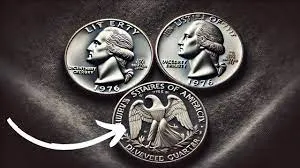Coins are more than just a piece of money. They symbolize windows into the past, archaeological digs from other eras, and often even treasures beyond anyone’s wildest dreams of fortune. Among the valuable finds for collectors and numismatists would be three ultra-rare dimes and some Bicentennial quarters, priced at an outrageous $4 billion each. Collectors around the globe have drooled over these very rare coins because they possess historical rarity and unique properties.
History of Rare Coins
Rare coins always have a story behind them, making them even more beautiful. Whether it is an error in minting, a low production number, or a design that is out of the ordinary, such qualities make them special in the numismatic world. The 3 coins in question are no exception-their rarity and value come from fascinating backstories and exceptional qualities.
The 1894-S Barber Dime
[also_read id=”40″]
Some of the rarest and most mysterious coins in U.S. history are some of the most famous. There is the 1894-S Barber dime. Only 24 were minted at San Francisco in 1894. There are fewer than 10 surviving today, and it is said that these were made to be gifts to bankers or for the mint’s account books.
The first reported find of a 1894-S Barber dime was at a flea market. The coin was found inside an old fruit jar. After being authenticated, this coin sold for millions of dollars. The legend grows further because this coin is considered the “Holy Grail” of collecting, due to the mysterious origins and extreme scarcity of the Barber dime.
The 1975 No-S Roosevelt Dime
There is another treasure which wins the hearts of the collectors and that is 1975 No-S Roosevelt dime. The error for this coin does not feature a “S” mint mark which is such an error in any case. Due to the presence of fewer numbers, this becomes one of the rarest dimes ever produced, and everyone in their lives gets to keep such a thing, though for a little time.
What makes this dime unique is the process of minting. No mint mark dimes were the Philadelphia issues, but this $ dime does not have the “S” mint mark of San Francisco although; however, its striking at the San Francisco place was coincidental since it is omitted today for it being unique and important for history, it is sold by millions of dollars.
Bicentennial Quarter

One of the coins in the history of numismatic is that of the Bicentennial quarter. This quarter was made in 1976, marking the 200th anniversary of the American independence. Even though billions were minted, the rare variants and errors skyrocketed in value.
One of the most valuable types is the double-die error Bicentennial quarter. The design of these coins contains duplications, with most common in the text or details. Another small batch of Bicentennial quarters was struck on silver planchets rather than the traditional copper-nickel alloy used in the vast majority of this type.
Collectors will pay as much as $500,000 for a double-die Bicentennial quarter, and the rarest are estimated to be worth as much as $4 billion, depending on condition and provenance. These coins tell the story of the allure of minting errors and the abiding interest in American history.
Why Are These Coins So Valuable?
[also_read id=”47″]
There are several factors that contribute to the astronomical value of these coins:
- Rarity: Low mintage coins or special features like the 1894-S Barber dime or 1975 No-S Roosevelt dime are extremely rare and, thus, highly desired and increase its value.
- Historical Significance: Coins with some historical association with a specific event, for example, the Bicentennial, carry more worth because of the cultural and historical value.
- Condition: the condition of a coin has much to do with price. Those in super, very good condition just drive the prices up.
- Minting Error: Missing mint marks, double die designs, very rare. Those are some real prize coins.
- Provenance: It’s the story where a coin was found and by whom that makes for the allure and value of a coin.
- Example: A coin found in a flea market or in a safety deposit box may attract an audience beyond its numismatic merit.
The Thrill of Discovery
These coin stories reflect the excitement and fun associated with collecting coins. Just imagine finding a billion-dollar coin in a jar full of spare change or in some old box hidden in the attic. It is just as exciting to the hunt as it is to the prize.
For instance, the 1894-S Barber dime discovered in a fruit jar from a flea market. This serves to remind people to check as well for rare coins in seemingly mundane places. Similarly, the double-die error on the Bicentennial quarter was discovered by a very keen collector who sifted through his loose change with perspicacious eyes.
Implications on Numismatics
It really carries some heavy ramifications within the numismatic world since seasoned collectors are forced to look a little harder into their collections, encouraging new entrants to the hobby. Such coins call to the surface the importance of third-party grading and authentication as the value here assigned mostly stems from conditions and provenances on such pieces.
Advice for Aspiring Coin Collectors
[also_read id=”49″]
If these stories of rare coins have motivated you, then here are a few tips to start your coin collection journey:
- Education: Know how to grade your coins, look for mint marks, and about the history of coins.
- Check Your Loose Change: Always look at your loose change for any rare or unique coins.
- Investment in Tools: Buy a magnifying glass, coin books, and storage materials for your coins.
- Join a community: Connect with fellow collectors via online forums, clubs, or social media groups.
- Get coins graded: Submit rare finds to reputable grading services to authenticate them.
Conclusion
[also_read id=”35″]
The 3 rare dimes and Bicentennial quarters worth $4 billion each are more than just coins-they are pieces of history, symbols of rarity, and testaments to the allure of numismatics. Their extra extraordinary value and intriguing backstories make them the ultimate dream for any collector. Whether you’re a seasoned numismatist or a curious beginner, these coins remind us of the treasures waiting to be discovered. So, keep an eye out—the next rare coin could be hiding in your pocket change.
FAQ’s
Q: How rare is the 1894-S Barber Dime?
A: The 1894-S Barber Dime is extremely rare, with only 24 minted and very few surviving today.
Q: How much is the 1913 Liberty Head V Nickel worth?
A: The 1913 Liberty Head V Nickel is estimated to be worth around $4 billion.
Q: Why is the 1976 Bicentennial Quarter valuable?
A: The 1976 Bicentennial Quarter is valuable because it commemorates the U.S. bicentennial and features a unique design.

